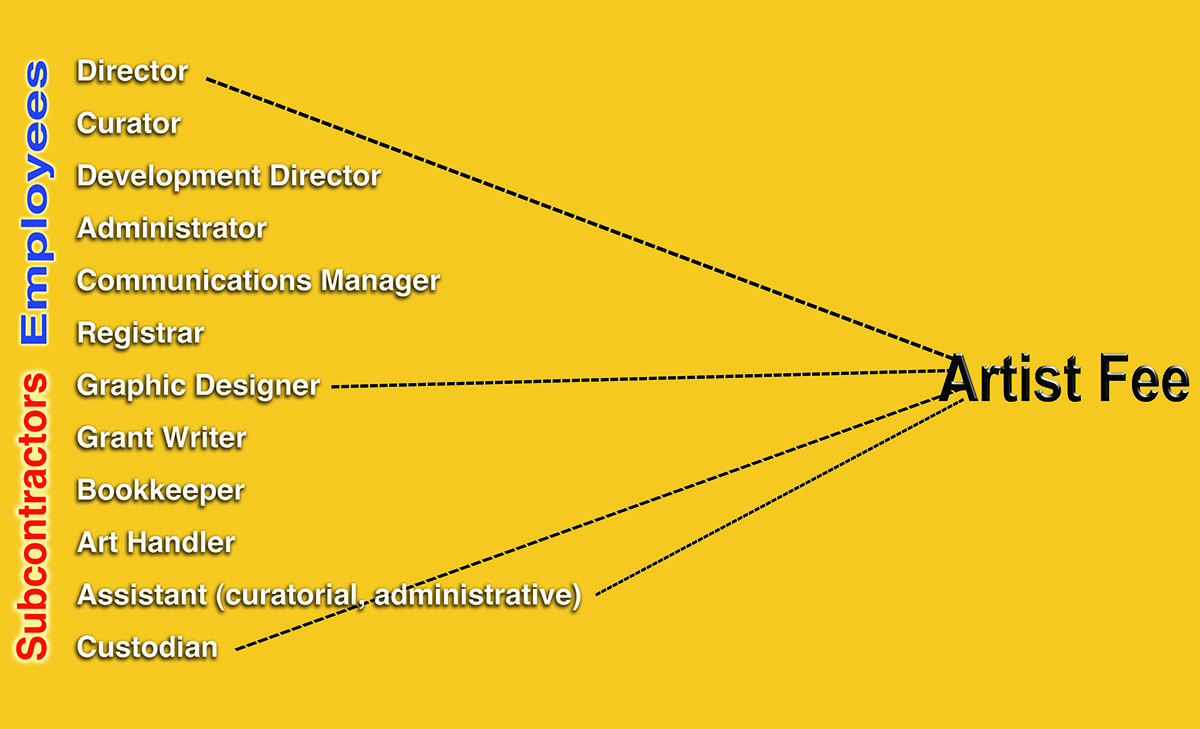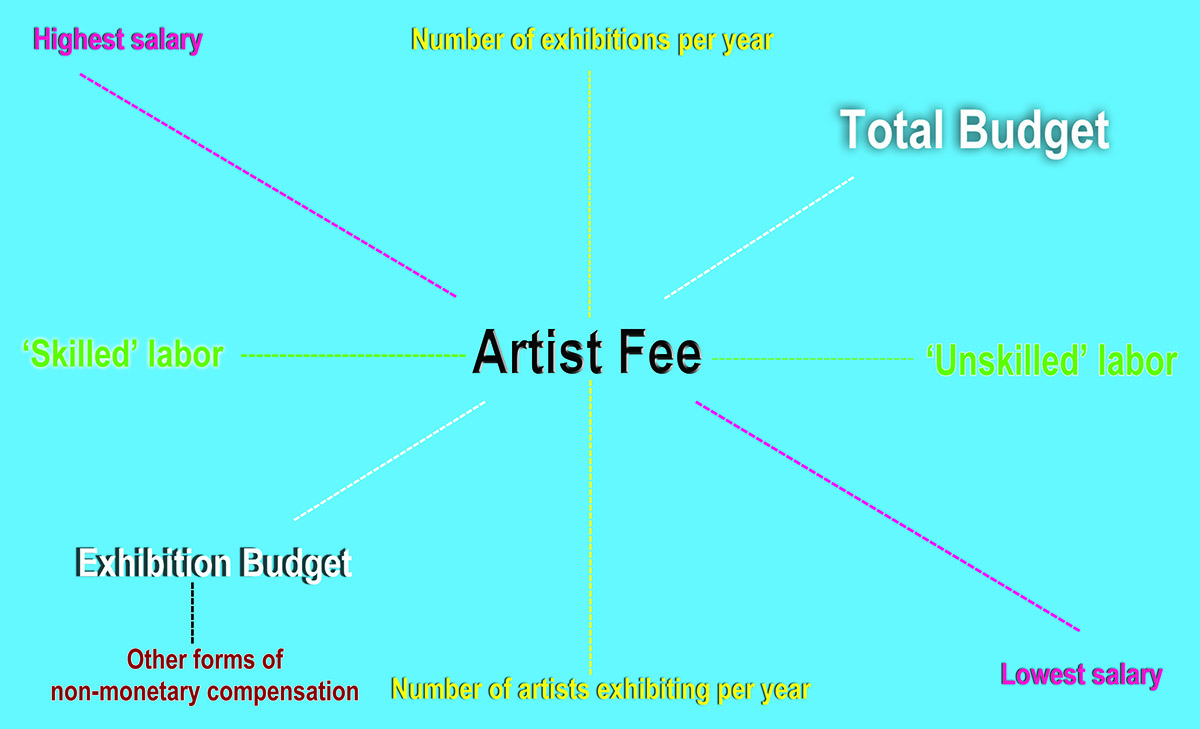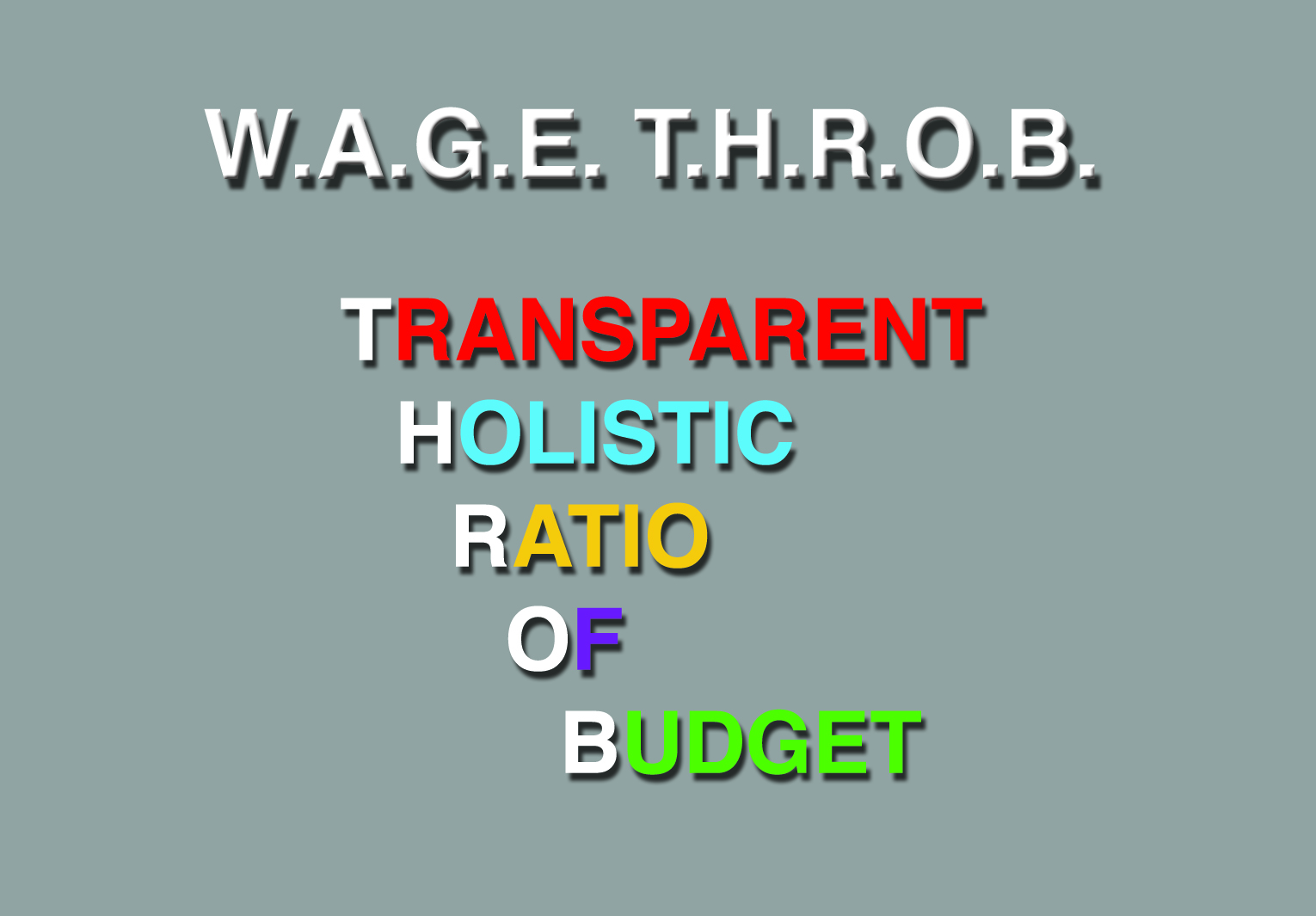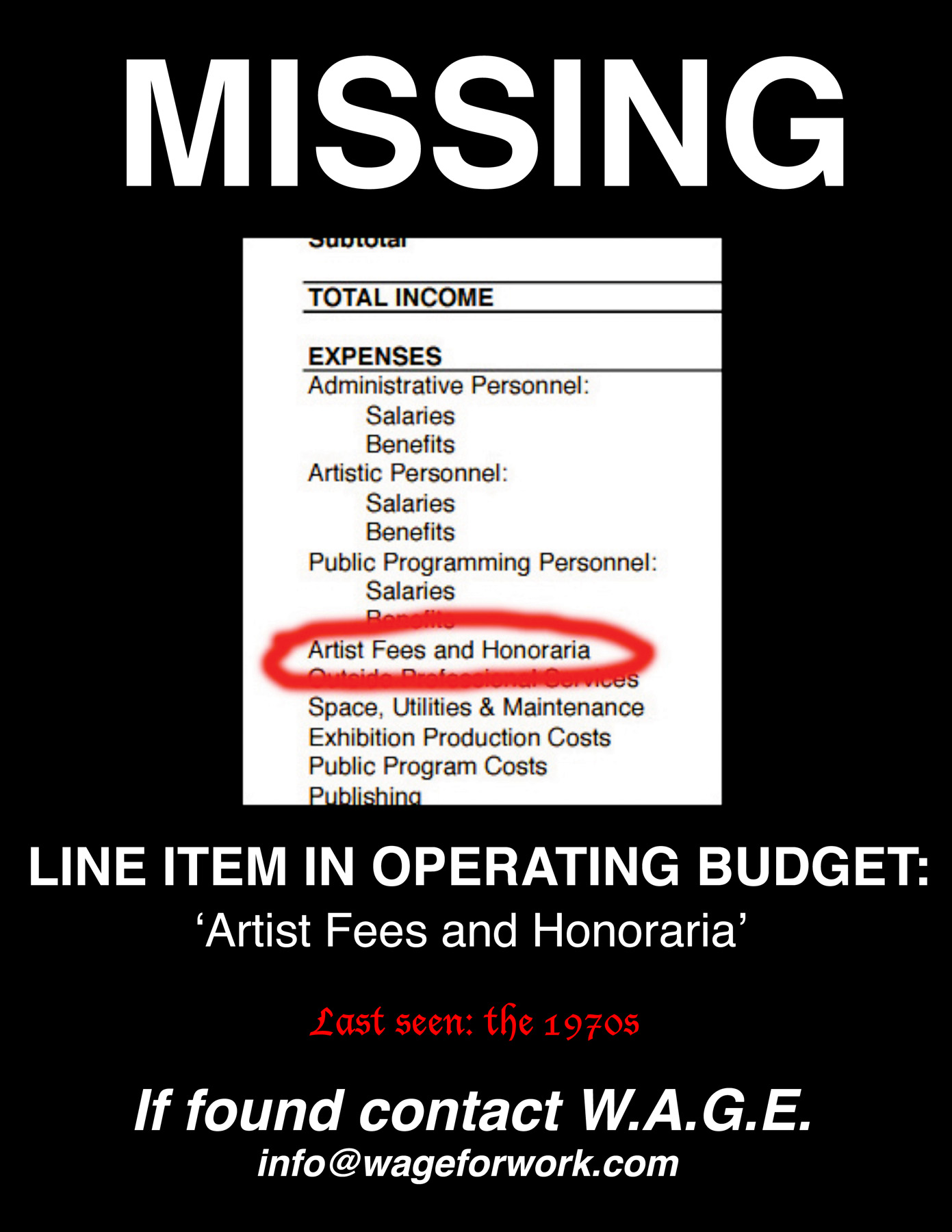Certification Development Materials

Produced between 2012 and 2014, the materials cataloged below trace the development of W.A.G.E. Certification as its core principles and policy began to take shape. Some materials were intended for internal use while others, like graphics and posters, were designed for public talks.
EARLY PRINCIPLES
As part of W.A.G.E.'s participation in Truth is Concrete at steirischer herbst (Graz, Austria) in 2012, we conducted an analysis of the festival's economy, an important step in the development of W.A.G.E. Certification. The statement below was drafted in response to a question posed to W.A.G.E. by a festival administrator who asked, what does equity mean to W.A.G.E.?
Equity Statement (2012)
Equity begins with recognizing that the contribution made by cultural producers is integral to the functioning of an arts institution.
Financial compensation for this contribution acknowledges its value.
Value might not be quantifiable in terms of the work done prior to collaborating with an institution, but payment must be conceived and established in direct relation to what an institution chooses to pay its employees and contractors.
Fee In Relation To (2012)


W.A.G.E. Certification Intake Form (2012)
The questions in this form are intended to help us understand how your organization structures its operating budget, and in particular the relativity between your expenses: the first stage of W.A.G.E. Certification is to establish the valuation of artist / performance / independent curatorial fees in relation to your organization’s total operating budget. We are also interested in understanding how your organization compensates artists in ways that are non-monetary, and the ways in which artists offer support to your organization.
Please answer these questions with as much detail/specific information as you can provide:
1. The Fee
a) Do you pay artist, performance and/or independent curatorial fees? b) If yes, which ones and how do you determine the amount of the fee? c) Are Artist Fees or Honoraria a line item in your budget? d) If no, what line item is it included within?
2. Other forms of compensation
a) Do you cover production costs? b) Do you cover travel costs? c) If yes, in what circumstances, and approximately what percentage is covered? d) What other ways do you compensate artists beyond the direct payment of artist fees?
3. Non-monetary compensation
a) Do you consider the exposure that your organization provides to cultural producers valuable? b) Could you monetize or quantify its value? c) What formula would you use to do that? d) Do you see your work with artists as being collaborative? e) If yes, how do you see your organization’s contribution as being essential to the realization of the work?
4. Support from artists
a) If an artist sells their work through your organization, do you take a percentage? b) If so, what is the percentage? c) Do you ask artists to donate their own work to support your organization? d) How many visual or performing artists are on your board?
5. Other expenses
a) What percentage is the director’s salary relative to the total organizational budget? b) What is the relativity between this and the artist fees you pay, if any? c) How do you determine the salaries of your employees?
6. Funding
a) When one expense increases, do you cut back on other line items or do you fundraise — or a combination of both? b) If you cut back, what expenses do you tend to cut back on? c) Does the type of funding available to you determine what kind of projects you do?
7. Equity
a) Please provide us with your mission statement. b) Describe what “fairness” and “equity” mean to your organization.
W.A.G.E. T.H.R.O.B. (2013)

POLICY DEVELOPMENT
Certification Requirements in Development (2012)
1. Artist Fees must be paid.
2. The Artist Fee is separate from — and must not be used to cover — travel, accommodation, installation, shipping, or any other expenses associated with production.
3. ‘Artist Fees’ must be included as a distinct and visible line item in annual operating and program budgets.
4. The size of the fee is determined in direct relation to:
Size of annual operating budget
Salaries of other employees and subcontracted workers who provide services and content, including the director, curator, administrators, designers, art handlers, assistants, and janitorial staff, among others.
When decreases in funding occur, the Artist Fee will only be reduced along with reductions to other expenses which may include salaries, marketing, fundraising, entertainment, travel, research & development, among others.
W.A.G.E. Certification considers equity not only in relation to the Artist Fee: the fee is a starting point in considering the value of all labor within an organization. Adjustments to employees’ salaries might also be recommended to bring them up to a standard that is equitable to the investment being made in artists, or the production of artists’ work.
MISSING (2013)

2014 W.A.G.E. Certification Summit
In January 2014, W.A.G.E. organized a summit to establish the policy for W.A.G.E. Certification. Using Artists Space as a test case, we looked closely at the organization's institutional structure and budget, considered the conditions under which it operates, and questioned the mechanisms it used to determine the organization, valuation, and compensation of labor. Certification's core principles had been developed over the preceding several years and were presented as a draft framework in the Summit's first session. The following seven sessions were each led by at least two designated participants and were designed to produce specific outcomes, as detailed in the Summit Agenda below. With the assistance of artist Park McArthur, over two days we talked through, negotiated, and arrived at an equation for fee payment and a revised set of principles.
January 13 & 14, 2014 @ Cage, 83 1/2 Hester Street, New York NY
Day 1, Monday
10-11am: Introductions and overview of W.A.G.E. Certification, an outline of the summit, its sessions, and expected outcomes.
Presentation by Lise Soskolne.
11am-1pm: Role and Responsibility of the Nonprofit from the Institutional Perspective
What are its priorities?
What is equity and how does it manifest beyond fair pay?
What are its responsibilities to employees/subcontractors/artists?
What are its fiscal and structural limitations
Outcome: Determine how the parameters of W.A.G.E. Certification relate to institutional ethics beyond the payment of artist fees.
Lead participants: Stefan Kalmár, Richard Birkett, Stephanie Jauch.
1 - 2pm: Lunch, food at Cage.
2-4pm: Non-monetary Compensation
What forms of non-monetary compensation do artists receive (production of new work, catalog/critical writing, coverage of expenses, exposure, social and cultural capital)?
What kind of non-monetary compensation (value) do institutions gain from artists?
Can and should non-monetary compensation be monetized?
If so, how?
Outcome: Determine the value of non-monetary compensation and whether it should be factored in as compensation within W.A.G.E. Certification.
Lead participants: Marina Vishmidt, with input on the institutional side from Richard Birkett.
4-6pm: Living Wage or Symbolic Fee
What is fair?
What is the objective of compensation within W.A.G.E. Certification?
Outcome: Establish parameters of compensation and minimum/base fee size.
Lead participants: Andrew Ross and Stephanie Luce.
Day 2, Tuesday
10am–12pm: Artists Space as Test Case
Look closely at Artists Space’s budget using criteria and terms established in first 3 sessions: institution’s stated priorities and definition of equity; non-monetary compensation; fairness of wages.
Test out what changes to budget would look like using these criteria.
Outcome: Determine what components of budget are flexible/negotiable and what are fixed/non-negotiable.
Lead participants: Stephanie Jauch, Andrea Fraser, with input from Stefan Kalmár, Richard Birkett, and possibly an Artists Space board member.
1–3pm: Fee in Relation To
Using criteria established in prior session, look at specific points of contact/line items in budget that reflect the institution’s stated mission/priorities/limitations and W.A.G.E.’s mandate of equity.
Select line items that the fee will be tied to.
Outcome: Determine points of contact in budget that the fee will be tied to.
Lead participants: Marina Vishmidt, Howie Chen.
3–6pm: Equation/Algorithm/Contract
Establish the relativity between artist fees and points of contact determined in prior session as an equation.
Sketch or write outline for best practices.
Outline contract(s)?
Outcome: Determine equation/fee structure; recommendations and/or requirements for ethical practices; outline of contracts if necessary.
Lead participants: Howie Chen, Andrea Fraser.
Notes
Instead of leading a session Alison Gerber will act as moderator/facilitator when necessary.
Session timing is approximate; some may be longer or shorter than others. We can take breaks.
There will be breakfast and food to snack on throughout the day.
All are invited to dinner and drinks on Day 2, location TBD.
2014 Policy Narrative
W.A.G.E. Certification was conceived as a self-regulatory model in response to an entrenched resistance to external regulation by both arts organizations and artists. Often expressed as a self-described 'allergy' to bureaucracy, it manifests within arts organizations as an ambivalence to articulate in any concrete way the terms of their engagement with artistic labor. Likewise, artists accept this state of ambiguity as a convenient means of maintaining the perceived autonomy of their work and practice.
Without a precise definition of the labor being supplied by artists, the financial gains it creates for organizations, or the criteria being used to determine compensation, this ambivalence has inevitably gelled into an institutional attitude that over time has taken shape as policy and is now endemic, making the exploitation of cultural labor appear to be a fundamental condition of participation in the arts.
W.A.G.E. does not accept ambivalence or ambiguity as conditions for determining rates of pay. W.A.G.E. Certification is an effort to eradicate these conditions by advocating for definition and hyper-clarity, and against the creation of sub-exceptions within an already exceptional economy.
If W.A.G.E. Certification is to function as a self-regulatory tool within a context that has foreclosed on the possibility of state regulation, how can it do so differently than other kinds of certification programs, particularly those that at best stand in for state regulation, and at worst work to wipe it out altogether? In the absence of government enforcement W.A.G.E. Certification recognizes that a consideration of scale is critical. The potential for larger institutions to consolidate power must be addressed — as do the precarious material conditions under which smaller organizations operate.
To this end, W.A.G.E. Certification was established as a three-tiered scalable model in January 2014 at the W.A.G.E. Summit, detailed below. Over the following 6 months, Certification was further developed through additional input, and then tested and refined through feedback from peers. The result is a clear set of guidelines and standards for self-regulation that organizations of any size can choose to adhere to. What follows is a summary of those guidelines and standards and the logics that were used to arrive at them.
I. Defining the Artist Fee
An 'honorarium' is defined by Wikipedia as a payment given for professional services that are rendered nominally without charge, while a 'fee' is the price one pays as remuneration for services. A fee, while being neither a salary nor a wage, still distinguishes itself from an honorarium by being actual compensation — not a representation of compensation.
Why then, have 'artist fees' never been conceived or implemented as compensation? Unlike rental, membership, insurance, planning, or consulting fees, the artist fee is an arbitrary sum that has come to symbolize the inability or unwillingness of arts organizations to determine compensation based on anything resembling the actual cost of the content or services provided by artists at a rate of fair compensation. By accepting the fee as a representation of compensation — essentially an excuse for not paying more — artists also accept that it is enough for organizations to represent the intention to compensate fairly, enabling the intention alone to supplant their actually doing so.
If this is to change, clarification is needed regarding what the fee is in fact compensation for. This first requires it to be untethered from the other expenses associated with mounting an exhibition or program. In other words, the first task is to define what the fee is not.
Basic Programming Costs and Services
The fee is not intended to cover what W.A.G.E. defines as Basic Programming Costs and Services. These are the baseline costs associated with mounting or executing programs as articulated by the organization's mission statement and constitute the basic services that artists can expect nonprofit organizations to provide, irrespective of specific content.
As contemporary conditions of precarity increasingly necessitate that workers supply the workplace infrastructure (laptop, cell phone, mobile office) W.A.G.E. asserts that in a visual arts context the opposite is true: the organization or institution, if nothing else, is the infrastructure that cannot be provided by the artist. Basic programming costs and services are not negotiable — they are the responsibility of the host organization and are required for certification.
Production Costs
The fee is also not intended to cover Production Costs which W.A.G.E. has defined as the costs associated with the production of a new work on a time-limited basis, sometimes resulting from a commission by an organization. Production costs are negotiated between artist and organization.
The coverage of production costs is not required for W.A.G.E. Certification but it is imperative that the negotiation of their coverage has no bearing on, or relationship to, the artist fee or the provision of basic programming costs and services. While in many cases it might be reasonable to expect an organization to cover production costs, W.A.G.E. elected not to make this a condition of certification because it would prohibit smaller organizations with lesser means from being certified.
W.A.G.E. recognizes the importance of small-scale organizations and the precarious conditions under which they operate, but many of the nonprofits that started out in precisely this way, emerging from the alternative space movement of the early 1970s, have since evolved into mid- to large-sized institutions that no longer serve as alternatives, certainly, the risk of exhibiting unaffiliated or 'untested' artists is not exclusively their domain. Instead, artists are now more likely to receive their first institutional exhibition only after they have been 'tested' in the commercial market.
With the financial and programmatic risk of supporting unaffiliated or lesser-known artists being shouldered by commercial galleries, the nonprofit must now distinguish itself by operating as a small museum or Kunsthalle, providing infrastructure, resources, and commissioning projects on a comparable or larger scale. Because the nonprofit's ability to cover these costs is limited by how much money it can raise through traditional funding streams, they are increasingly being subsidized by the commercial galleries that represent affiliated artists when they exhibit in nonprofits.
Nonprofit and for-profit economies are already in dangerous overlap when collectors and dealers serve as board members where they have the potential to influence programming decisions in favor of artists they collect or sell in order to inflate the price of their investment. Potential for the same conflict of interest to occur exists when an artist's gallery subsidizes production costs. In anticipation of profit from future sales, the commercial gallery is likely to encourage and eagerly finance capital-intensive art works, thereby yoking an artist into a Faustian transaction in which the subsidy must eventually be repaid as a loan, with the funds subtracted from the future sales of their work.
Whether or not the sale of the work produces revenue for artist or organization, W.A.G.E. Certification does not recognize the coverage of production costs as a form of compensation. To consider production as a monetizable investment would require addressing the second life of the work in the commercial marketplace, and as such would mean recognizing artistic labor as a form of commodity production, thus encouraging capital-intensive projects and their circulation within the speculative market. Instead, W.A.G.E. Certification locates itself within a services model, defining compensation on the basis of content or services provided.
II. Defining Content and Services
W.A.G.E. does not distinguish between visual artists, performers, dancers, poets, filmmakers, writers, musicians and others who supply content and provide services in a visual arts context. All are considered artists for which they receive artist fees. Use of the word 'artist' is inclusive of a single person or multiple persons operating as a collaborative or collective.
W.A.G.E. does distinguish between the "Contracted Artist" who has been engaged by an organization to participate in programs, and the "Sub-Contracted Artist" who may be engaged by an artist to participate in a project or program.
W.A.G.E. has identified fourteen units of content or services commonly supplied by artists in a visual arts context. Each unit constitutes its own fee category for which a minimum price has been assigned on the basis of the labor (time) involved in producing content and services once an artist has entered into a transactional relationship with an organization, the assigned price does not account for labor that may have been expended prior to that transaction but it does account for differences between existing content which requires less labor and new content which requires more.
As such, fees are lower for the provision of existing content, such as the re-performance of an existing work, the delivery of a standard prepared artist talk, a reading, or the reprinting of a text. Fees are higher when new content is required, such as for a commissioned performance or artwork, the development of a lecture, seminar or workshop around an established thematic, or the writing of a new text for an exhibition catalog.
The fee categories Existing Text for Publication and Commissioned Text for Publication are limited to writing produced in a visual arts presenting context. This excludes art reviews as well as critical writing published in some nonprofit visual arts focused journals which qualify as a nonprofit publishing context and for which W.A.G.E. will develop a separate fee schedule.
Within W.A.G.E. Certification for a visual arts presenting context, texts for publication generally include writing produced for exhibition catalogs, monographs, and qualifying online or print journals. A text may be a long or short-form essay produced by a single person or an interactive text produced in conjunction with other people or another person, such as a roundtable discussion, survey/questionnaire, or interview. Writing produced by artists for their own exhibition is covered under the Solo Exhibition fee.
III. Fee Calculation
W.A.G.E. Certification's fee calculator is a three-tiered model that determines fair compensation using two mechanisms: it establishes an sector-wide minimum or 'compensation floor' for fees in fifteen fee categories, and it scales these fees up from the floor using a fixed percentage of an organization's total annual operating expenses (TAOE).
A compensation floor is a low-wage economy tool intended to benefit those who struggle in closest proximity to the bottom, setting a clear baseline standard for compensation that renders anything less to be unacceptable. By guaranteeing a minimum income, it also opens the field up to artists for whom the risk of non-compensation is not an option and provides them with the agency to advocate for themselves.
Taken as a minimum payment standard, W.A.G.E.'s compensation floor is appropriate to smaller organizations with limited means, but it is inappropriate to those with larger budgets that can afford to pay higher fees. Unlike other fee schedules that account for size differentials by distinguishing only between TAOE below or above $500,000, W.A.G.E. determines equitable compensation in direct proportion to each organization's actual TAOE — in other words, to its actual financial means — which vary greatly within a philanthropic economy that is also steeply stratified. This scaling mechanism enables precise distinctions to be made between organizations, and through these distinctions to hold each proportionately accountable.
A nonprofit organization's TAOE can be found on Line 18 of the 990 or 990-PF return, an annual tax document required by IRS disclosure regulations to be made available for public inspection. TAOE excludes the value of any assets and is therefore more precise in representing the sum total of all that an organization actively deems essential to carrying out its mission. Unlike annual income — a figure that would enable an organization to make excuses for non-compensation based on not having raised enough money — annual expense indicates an organization's priorities: both what it has chosen to raise money for and what it has chosen to spend money on.
W.A.G.E. recognizes that the TAOE of large collecting museums like MoMA, The Guggenheim or The Whitney are higher because they include expenses associated with acquisitions, collection maintenance, and the management of retail outlets, and that these expenses seem unrelated to the cost of mounting exhibitions by living artists. As a corrective to this potential distortion, W.A.G.E. considered tying the fee to total annual exhibition expense instead but soon recognized that if an exhibition involved the production of a capital-intensive project, its budget would be higher and in turn so would the fee, thus creating an incentive for artists and commercial galleries to inflate exhibition budgets and be rewarded for the production of capital-intensive work that may command higher prices in the speculative market.
W.A.G.E. also recognizes that at the level of the largest institutions, those with TAOE over $15,000,000 artist fees reach unrealistic levels — in many cases exceeding the average salary of an institution's full-time employees. If the objective of a compensation floor is to stop the freefall in the race to the bottom, W.A.G.E. has included a compensation 'ceiling' that is likewise intended to stop the race to the top. At the level at which artists can leverage their market prices to command higher fees, W.A.G.E. has incorporated a ceiling to ensure that nobody unduly profits from the redistribution of wealth — including artists. At TAOE of $15,000,000 and over, the fee must be no more the average salary of an institution's full-time employees.
Because W.A.G.E. Certification calls for a nonprofit organization's operating expenses to reflect its priorities, and that core to those priorities is assigning equitable prices to artistic labor, W.A.G.E. asserts that an organization's TAOE does in fact accurately represent its means. Whether a small organization or a large collecting museum, under W.A.G.E. Certification "Artist Fees" must be listed as a visible line item in both operating and exhibition budgets, necessitating that funding be raised for them as an annual expense. In other words, artist fees are part of the cost of doing business.